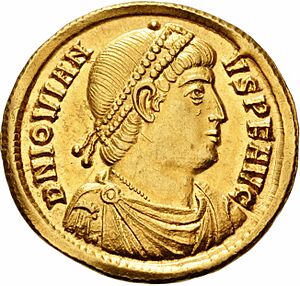Jovian (emperor) facts for kids
Quick facts for kids Jovian |
|||||
|---|---|---|---|---|---|

Solidus depicting Jovian
|
|||||
| Roman emperor | |||||
| Reign | 27 June 363 – 17 February 364 | ||||
| Predecessor | Julian | ||||
| Successor | Valentinian I (West) Valens (East) |
||||
| Born | 331 Singidunum, Moesia Superior, Roman Empire |
||||
| Died | 17 February 364 (aged 33) Dadastana, Anatolia, Roman Empire |
||||
| Burial | Church of the Holy Apostles, Constantinople | ||||
| Spouse | Charito | ||||
| Issue | Varronianus another son |
||||
|
|||||
| Father | Varronianus | ||||
| Religion | Nicene Christianity | ||||
Jovian (born 331 – died 17 February 364) was a Roman emperor who ruled for a short time, from June 363 to February 364. He was part of the emperor's special guard. He joined Emperor Julian on a military trip against the Sasanian Empire (an ancient Persian empire). When Julian died in battle, the tired Roman army chose Jovian to be the new emperor.
Jovian had to make a difficult peace deal with the Sasanids because his army was stuck. He spent the rest of his seven-month rule traveling back to Constantinople, the capital city. He died on the way, never reaching Constantinople. Jovian was the last emperor to rule the entire Roman Empire during his reign.
Becoming Emperor
Jovian was born in 331 in Singidunum (which is now Belgrade in Serbia). His father, Varronianus, was a commander of the emperor's bodyguards. Jovian followed in his father's footsteps and joined the guards too.
He married a woman named Charito, and they had two sons. One son was named Varronianus, but the other son's name is not known.
In 363, Jovian was with Emperor Julian during a military campaign in Mesopotamia against the Persian king, Shapur II. During a battle, Julian was badly hurt and died on June 26, 363.
The Roman army needed a new leader quickly. An older official named Salutius was offered the job, but he said no. So, the army chose Jovian to be their new emperor. This was interesting because Julian had brought back paganism, but Jovian was a Christian.
Jovian's Rule
Right after becoming emperor, Jovian continued the army's retreat from Persia. The Sasanid forces kept attacking them. The Roman army finally reached the city of Dura by the Tigris River. They hoped to cross the river to get back to Roman territory.
When they couldn't build a bridge across the river, Jovian had to ask for a peace treaty. The terms of the treaty were very tough for Rome. To get his army safely home, Jovian agreed to a 30-year peace. Rome had to give up five of its provinces and several important fortresses to the Sasanids. Rome also agreed not to help the Kingdom of Armenia against the Sasanids. Many Romans thought this treaty was a disgrace.
After crossing the Tigris, Jovian sent messengers to the western part of the Roman Empire to tell them he was the new emperor. The army then marched to Nisibis, a city that was now part of the lands given to the Sasanids. The people of Nisibis were very sad to hear this news and were given three days to leave their city.
In September 363, Jovian arrived in Edessa. There, he made two important announcements. One was about ending the war with Persia. The other was about giving back lands that Julian had taken from the government and given to pagan temples.
When Jovian reached Antioch in October 363, the people were very angry. They wrote insulting messages about him around the city. In response, Jovian ordered the Library of Antioch to be burned down. He left Antioch in November 363 to continue his journey back to Constantinople.
By December 363, Jovian was in Ancyra. There, he named his baby son, Varronianus, a consul. This was a high political position.
Jovian was found dead in his tent on February 17, 364, while traveling from Ancyra to Constantinople. He was in a place called Dadastana. His death was not fully investigated, but it might have been caused by poisonous fumes from newly painted walls in his tent or from a charcoal heater. Jovian was 33 years old when he died. He was buried in the Church of the Holy Apostles in Constantinople.
After Jovian's death, two brothers, Valentinian I and Valens, became emperors. They later divided the empire between them. To make sure Jovian's son, Varronianus, could never become emperor, he was blinded.
Bringing Back Christianity
Jovian was a Christian, and he changed some of Julian's policies. In Edessa, he met with several bishops, including Athanasius, who had just returned from being sent away. Jovian welcomed Athanasius and allowed him to return to his church duties. Athanasius gave Jovian a letter that supported the Nicene Creed, a key Christian belief.
When Jovian arrived in Antioch, he received another letter from church leaders. They asked for Meletius to be made bishop again.
By September 363, Jovian brought back the labarum (a Christian symbol) as the army's flag. He also canceled Julian's laws against Christians. However, he did not close any pagan temples. He announced that people could have full freedom of religion. But he did ban magic and fortune-telling. Even though he supported Nicene Christian beliefs, he did not make any laws against other Christian groups like the Arians. A church historian named Philostorgius said that Emperor Jovian "restored the churches to their original uses, and set them free from all the vexatious persecutions inflicted on them by the Apostate Julian."
See also
 In Spanish: Joviano para niños
In Spanish: Joviano para niños

